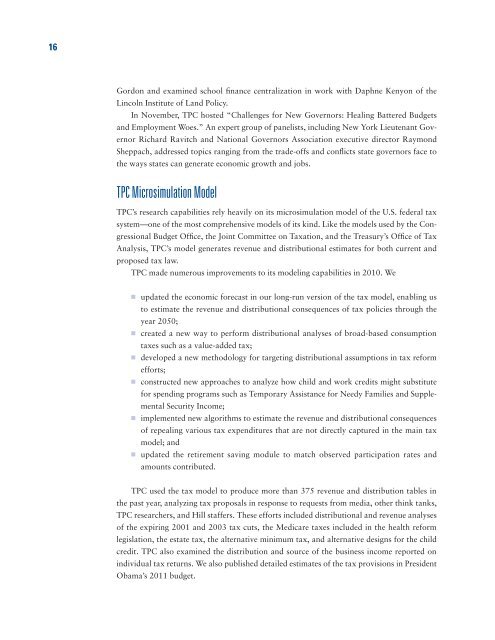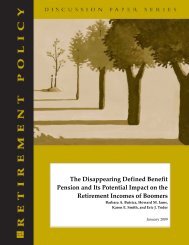View the entire report as a PDF - Tax Policy Center
View the entire report as a PDF - Tax Policy Center
View the entire report as a PDF - Tax Policy Center
Create successful ePaper yourself
Turn your PDF publications into a flip-book with our unique Google optimized e-Paper software.
16<br />
Gordon and examined school finance centralization in work with Daphne Kenyon of <strong>the</strong><br />
Lincoln Institute of Land <strong>Policy</strong>.<br />
In November, TPC hosted “Challenges for New Governors: Healing Battered Budgets<br />
and Employment Woes.” An expert group of panelists, including New York Lieutenant Governor<br />
Richard Ravitch and National Governors Association executive director Raymond<br />
Sheppach, addressed topics ranging from <strong>the</strong> trade-offs and conflicts state governors face to<br />
<strong>the</strong> ways states can generate economic growth and jobs.<br />
TPC Microsimulation Model<br />
TPC’s research capabilities rely heavily on its microsimulation model of <strong>the</strong> U.S. federal tax<br />
system—one of <strong>the</strong> most comprehensive models of its kind. Like <strong>the</strong> models used by <strong>the</strong> Congressional<br />
Budget Office, <strong>the</strong> Joint Committee on <strong>Tax</strong>ation, and <strong>the</strong> Tre<strong>as</strong>ury’s Office of <strong>Tax</strong><br />
Analysis, TPC’s model generates revenue and distributional estimates for both current and<br />
proposed tax law.<br />
TPC made numerous improvements to its modeling capabilities in 2010. We<br />
77<br />
updated <strong>the</strong> economic forec<strong>as</strong>t in our long-run version of <strong>the</strong> tax model, enabling us<br />
to estimate <strong>the</strong> revenue and distributional consequences of tax policies through <strong>the</strong><br />
year 2050;<br />
77<br />
created a new way to perform distributional analyses of broad-b<strong>as</strong>ed consumption<br />
taxes such <strong>as</strong> a value-added tax;<br />
77<br />
developed a new methodology for targeting distributional <strong>as</strong>sumptions in tax reform<br />
efforts;<br />
77<br />
constructed new approaches to analyze how child and work credits might substitute<br />
for spending programs such <strong>as</strong> Temporary Assistance for Needy Families and Supplemental<br />
Security Income;<br />
77<br />
implemented new algorithms to estimate <strong>the</strong> revenue and distributional consequences<br />
of repealing various tax expenditures that are not directly captured in <strong>the</strong> main tax<br />
model; and<br />
77<br />
updated <strong>the</strong> retirement saving module to match observed participation rates and<br />
amounts contributed.<br />
TPC used <strong>the</strong> tax model to produce more than 375 revenue and distribution tables in<br />
<strong>the</strong> p<strong>as</strong>t year, analyzing tax proposals in response to requests from media, o<strong>the</strong>r think tanks,<br />
TPC researchers, and Hill staffers. These efforts included distributional and revenue analyses<br />
of <strong>the</strong> expiring 2001 and 2003 tax cuts, <strong>the</strong> Medicare taxes included in <strong>the</strong> health reform<br />
legislation, <strong>the</strong> estate tax, <strong>the</strong> alternative minimum tax, and alternative designs for <strong>the</strong> child<br />
credit. TPC also examined <strong>the</strong> distribution and source of <strong>the</strong> business income <strong>report</strong>ed on<br />
individual tax returns. We also published detailed estimates of <strong>the</strong> tax provisions in President<br />
Obama’s 2011 budget.





